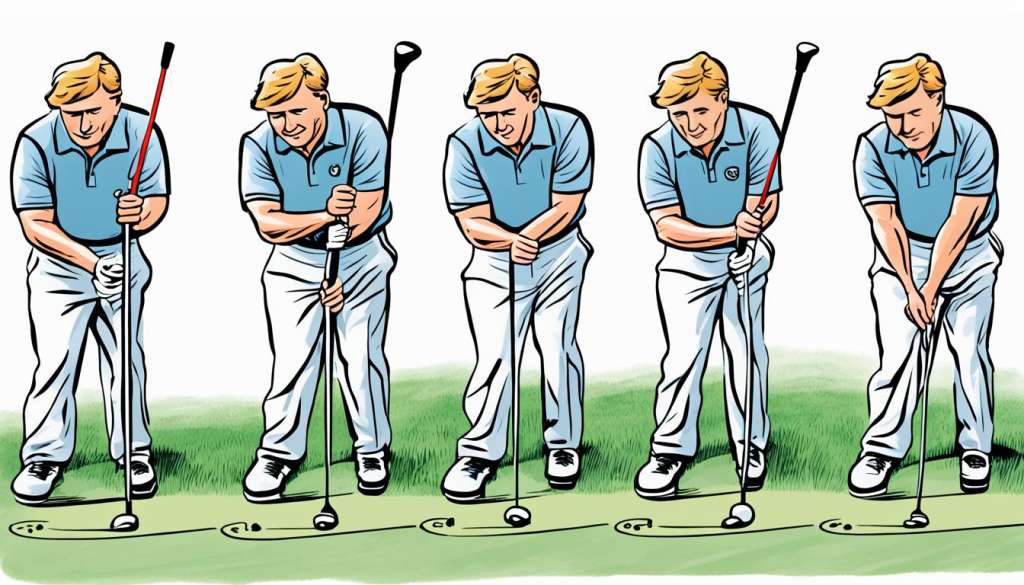Your golf swing mechanics are key to improving your game and lowering scores. This guide will help you master the basics of a proper grip, perfect your swing plane, and improve your body mechanics for a better golf swing.
To boost your performance on the course, you’ll learn about important elements like stance, posture, and ball positioning. We’ll go through each part of the swing, from the takeaway to the follow-through. This ensures you know how to do each step right.
By focusing on body rotation and weight transfer, you’ll learn how to hit more powerful and accurate shots. We’ll look into the one-plane and two-plane swings. This will help you pick the best approach for your style.
This guide offers practice drills, tips for fixing common mistakes, and advanced techniques. It will give you the knowledge to improve your golf swing mechanics and elevate your game.
Understanding the Fundamentals of Golf Swing Mechanics
Golf swing basics are key to playing well. Learning these basics can really boost your game. Let’s look at the main parts of a good golf swing.
The importance of proper grip
Your grip is how you connect with the club, so it’s vital for control and hitting accurately. There are three main grip styles:
- Baseball grip: All fingers wrap around the club
- Overlap grip: Pinky finger of trailing hand rests between index and middle finger of lead hand
- Interlock grip: Pinky finger of trailing hand interlocks with index finger of lead hand
Try out these grip styles to see which one feels best and helps you swing the most accurately.
Achieving the correct stance and posture
Your stance and posture are key for a strong and precise swing. Here’s how to stand right:
- Stand with feet shoulder-width apart
- Bend knees slightly
- Distribute weight evenly between both feet
- Tilt from the hips, keeping your back straight
- Let arms hang naturally
- Align shoulders with your target line
Ball positioning for different clubs
Where you place the ball changes with the club you’re using. Here’s a quick guide:
| Club | Ball Position |
|---|---|
| Driver | Inside left heel |
| Fairway Woods | Just inside left heel |
| Mid-Irons | Center of stance |
| Short Irons | Just right of center |
| Wedges | Center to right of center |
By focusing on grip, stance, posture, and ball position, you’ll lay a strong foundation for better golf.
Golf Swing Mechanics Guide: Breaking Down the Swing Phases
Understanding golf swing phases is key to improving your game. Let’s look at each stage to help you refine your technique. This will boost your performance on the course.
The Takeaway: Starting Your Swing Right
The takeaway is the start of your swing. Move your chest and arms together, keeping a triangle between your shoulders and hands. Keep your wrists firm and rotate your shoulders to start the club moving away from the ball.
Mastering the Backswing
In the backswing, focus on turning your shoulders and hips. Let your wrists hinge naturally as you rotate. Your left arm (for right-handed golfers) should stay straight, making a wide arc for more power.
The Crucial Transition Phase
The transition is when you move from backswing to downswing. Start with your lower body moving. Your hips should turn towards the target while your upper body finishes the backswing. This powerful coil drives your downswing.
Executing a Powerful Downswing
In the downswing, focus on hip rotation and keeping your lead shoulder in place. Let your arms drop as your body rotates. Keep your wrists cocked until just before hitting the ball to get the most speed and power.
Follow-through and Finish
The follow-through is vital for a complete swing. Keep moving after hitting the ball and rotate fully. Finish with your hands up and your weight on your front foot. A balanced finish shows a well-done swing.
Mastering these golf swing phases will make your swing more consistent and powerful. Practice each part separately before putting them together into one smooth motion.
The Role of Body Rotation in Your Golf Swing
Body rotation is key to a powerful and accurate golf swing. It happens when your torso and hips work together. This technique boosts both distance and precision.
Start with a good setup for your golf swing. As you swing back, your shoulders move away from the target. This makes your core muscles tense. Your hips should turn less than your shoulders during this step.
When you swing down, your lower body leads. Your hips and then your torso move towards the target. This movement lets you transfer energy well from your body to the club, making a powerful hit.
To get better at body rotation:
- Practice with a club across your shoulders to feel the proper rotation
- Focus on keeping your spine angle the same throughout the swing
- Use resistance bands to strengthen your core muscles
- Work on separating your upper and lower body movements
Good body rotation boosts power and makes your swing more consistent and accurate. Mastering this key part of your swing will greatly improve your game.
| Swing Phase | Body Rotation | Key Focus |
|---|---|---|
| Setup | Neutral position | Proper alignment |
| Backswing | Shoulders rotate 90°, Hips 45° | Maintain spine angle |
| Downswing | Hips lead, followed by torso | Sequential unwinding |
| Impact | Hips open, shoulders square | Power transfer |
| Follow-through | Full rotation to target | Balance and finish |
Mastering Weight Transfer for Improved Power and Accuracy
Weight transfer is key to your golf swing. It affects your power and accuracy. Mastering this skill will greatly improve your game.
Shift from Back Foot to Front Foot
Begin your swing with your weight on the inside of your back foot. Move it to your front foot as you swing. This shift adds power to your shot.

Timing Your Weight Transfer
Getting the timing right is crucial for a smooth swing. Start shifting your weight on the downswing. This keeps your motion fluid and boosts your swing power. Practice to build muscle memory and better balance.
Common Weight Transfer Mistakes to Avoid
Many golfers face challenges with weight transfer. Here are common mistakes:
- Shifting too early, leading to loss of power
- Moving weight too late, causing inconsistent shots
- Failing to complete the transfer, reducing accuracy
| Phase | Weight Distribution | Common Error |
|---|---|---|
| Setup | 50/50 | Leaning back |
| Backswing | 70% back foot | Swaying |
| Downswing | 70% front foot | Early shift |
| Follow-through | 90% front foot | Falling back |
Focus on these weight transfer aspects to improve your swing. Remember, practice is key. Spend time perfecting this skill for better game performance.
The One-Plane vs. Two-Plane Swing: Which is Right for You?
Golf swing planes are key to your swing technique. Knowing the difference between one-plane and two-plane swings helps you pick the best one for your game.
A one-plane swing keeps the same angle all the way through. It’s great for golfers who are flexible. This method helps you hit the ball more consistently.
On the other hand, a two-plane swing has a steep backswing and a flat downswing. It suits players who are less flexible but have good timing. This swing can make your swing faster and your ball go farther.
| Aspect | One-Plane Swing | Two-Plane Swing |
|---|---|---|
| Angle | Consistent throughout | Steeper backswing, flatter downswing |
| Flexibility Required | Higher | Lower |
| Timing | Less critical | More important |
| Ball Flight | Promotes draw | Varies |
| Power Potential | Moderate | Higher |
Deciding between a one-plane and two-plane swing depends on your body and what you want your ball flight to be like. Try out both methods to see which feels more natural and gives you better results.
Developing Consistency: Practice Drills for Better Swing Mechanics
Improving your golf swing consistency takes practice and the right tools. Let’s look at effective drills to refine your technique and boost your performance on the course.
Alignment Stick Exercises
Alignment sticks are great for improving your swing mechanics. Place them parallel to your target line to see your hand path during the swing. This drill helps you keep the right swing plane and boosts your accuracy.

Mirror Practice Techniques
Mirror practice is a top way to check your posture and swing mechanics. Set up a full-length mirror in your practice area and swing slowly. Focus on your setup, backswing, and follow-through. This lets you spot and fix any swing errors.
Video Analysis for Self-Improvement
Video analysis is a key tool for fine-tuning your golf swing. Record your swings from various angles and review them in slow motion. Look at your body rotation, weight transfer, and club path. This helps you see areas to improve and track your progress.
Adding these drills to your routine will improve your swing consistency. Remember, regular practice and focus on proper mechanics are key. With dedication and the right techniques, you’ll see big improvements in your game.
Common Golf Swing Flaws and How to Fix Them
Golf swing flaws can really get in the way of even the best players. Knowing how to fix these problems is crucial for better play. Let’s look at some common swing issues and how to solve them.
The slice is a common issue, making the ball curve a lot from left to right for right-handed golfers. To fix a slice, aim for an inside-out swing path. Hold the club with your left hand a bit to the right on the handle. Practice swinging along an imaginary line from inside the ball to outside the target line.
Hooks are another problem, making the ball curve sharply from right to left. To fix a hook, change your grip by turning your left hand a bit to the left. Work on a swing path that moves more from outside to inside through impact. This change helps straighten your shots and cuts down on spin.
| Swing Flaw | Cause | Correction |
|---|---|---|
| Slice | Out-to-in swing path | Inside-out path, proper grip |
| Hook | In-to-out path | Adjust grip, modify swing path |
| Improper Weight Transfer | Poor sequencing | Practice balance throughout swing |
Improper weight transfer can cause inconsistent shots. To fix this, work on shifting your weight from your back foot to your front foot during the downswing. Keep your balance steady throughout the swing for better control and power.
First, figure out what golf swing flaws you have. Then, make specific changes and practice regularly. You’ll start to see improvements in your game.
Advanced Techniques to Refine Your Golf Swing Mechanics
Are you ready to boost your golf game? Let’s dive into some advanced techniques to improve your swing mechanics. These methods will help you hit the ball harder, be more consistent, and control your ball flight better.
Incorporating lag for increased power
Golf swing lag is key to hitting harder. It means waiting to release the clubhead right before it hits the ball. This delay creates a whip-like effect, making the clubhead speed up and your drives longer. To practice lag, use a training aid like the “Lag Shot” golf club to feel the right lag position in your swing.
Perfecting your swing tempo
Swing tempo is how smoothly and at what pace you swing. A steady tempo helps you hit the ball better and perform better overall. To get better at tempo, swing with a metronome or count in your head. Aim for a 3:1 ratio between your backswing and downswing for the best results.
Fine-tuning your swing path
Your swing path affects your shot’s direction and shape. To improve your path, swing along an imaginary line from the ball to your target. Use alignment sticks on the ground to see and practice the right swing path. Remember, these advanced techniques take time and regular practice to get right. Consider getting help from a golf pro to refine your swing mechanics.

